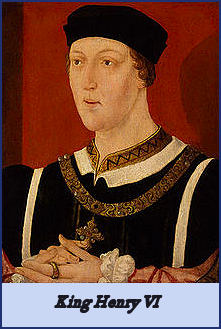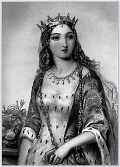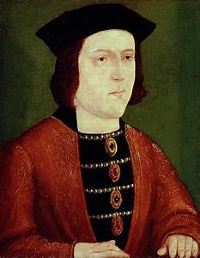The Wars of the Roses
Part 2: Violence and Devastation 
Henry VI (right) had little interest in the war abroad, preferring to focus on things much closer to home, like his own religious studies. In 1453, he suffered the first of a number of mental breakdowns and had to hand over even more of the governing of the country to his council. Richard of York was named Lord Protector, over the objections of the queen, who wanted Edmund Beaufort, Duke of Somerset to rule in the king's stead. York then removed his rival, Beaufort, from the scene by having him arrested and taken to the Tower. The following year, the two men's fortunes reversed, as the king awakened from his torpor and put Somerset back in power, at the same time relieving York of his. York did not go quietly, and the two powerful men fought against each other, each with an army at his back. 
The first official battle of the Wars of the Roses was on May 22, 1455, at St. Albans. The Yorkist forces won the day, and Somerset was killed in the process. York also took an injured Henry prisoner, and Queen Margaret (right) and her young son went into exile. Henry also suffered another bout of insanity at this time, and York was named Protector of the Realm. An uneasy truce followed the full fury of St. Albans and lasted for a handful of years; all the while, Margaret and her allies were working behind the scenes, looking for an opportunity. In 1459, the two sides fought again at the Battle of Blore Heath. The September 23 battle was another victory for York, even though his forces were just half of the Lancastrians. Just a few weeks later, however, the fortunes switched. The Lancastrian forces, thanks in part to a large number of the York force who fled the field, won a decisive victory at the Battle of Ludford Bridge. Queen Margaret declared York an outlaw and seized his property; York fled to Ireland. One of York's greatest defenders was Richard Neville, Earl of Warwick. He it was who had joined York's cause at St. Albans, providing the much-needed money and muscle. He it also was who marched at the head of an army in June 1460 toward London. The two sides went into battle again, near the town of Northampton, on July 10. In the midst of the battle, Lord Grey switched sides, throwing in his lot with York; that turned the tide enough to produce a resounding Yorkish victory. York took Henry prisoner and forced the king to renounce his son's claim as heir apparent and instead name York as the one who would next be king. York's victory was short-lived, however. He died on Dec. 31, 1460, at the Battle of Wakefield. The Yorkist forces had been holed up in Sandal Castle but, for some reason, had sallied forth out of their strong defensive position in order to confront a larger Lancastrian force. Queen Margaret's triumph was rich; she took special pleasure in displaying York's mutilated body for all to see. The Wars of the Roses are generally known for their cruelty, and it was quite common for the victors to send messages to their opponents by displaying leaders' corpses or body parts in public places. As well, conduct to soldiers on the battlefield and especially to those taken prisoner was especially harsh in these conflicts. 
York's son, Edward (left), took up his father's mantle, rallying the Yorkist forces. He led the army into conflict near the Welsh border on Feb. 2, 1461, at the Battle of Mortimer's Cross. Most of the Lancastrian royalty were in attendance at this battle: Queen Margaret and Edward, Prince of Wales were accompanied by Owen and Jasper Tudor, father and son supporters of Henry VI. The Tudors were related to Henry VI and were powerful players in south Wales. Despite all of the royal luminaries on the Lancastrian side, it was the Yorkist armed forces who carried the day. Owen Tudor was unsuccessful in escaping and was killed. Also of note in this battle was a prediction by Edward that he had a vision of three suns at dawn and that he interpreted it as meaning that he and his two brothers–George and Richard, both of whom were present at the battle–would emerge victorious. Edward later adopted the "sunne in splendour" as his personal emblem. Edward had marched west toward Wales in order to engage the Tudors at Herfordshire. Because of that, Edward was unable to meet up with his father's (and now his) major ally, Warwick. Thus, Warwick and his smaller force were left to their own devices when they came into the sights of the much larger Lancastrian army. At the Second Battle of St. Albans, on February 17, Warwick had attempted to block the Lancastrian advance through the town by setting up fortifications in the north, but his opponents rendered the fortifications unnecessary by swinging round to the west and engaging the Yorkist forces from the rear. The result was a smashing victory for Queen Margaret; she even got her husband back because the retreating Yorkist forces left the king sitting under a tree, unharmed. In keeping with the savagery of the times and this conflict, the Lancastrian forces pillaged and plundered their way through the countryside, marching toward London. The people of the capital city closed up the gates, dreading the devastation that had already been suffered by other towns in the Lancastrians' path. York and Warwick were able to meet up and get to London first, however, and they had a much more favorable reception from the people there. In fact, Warwick, one of the most powerful men in the realm, proclaimed Edward the rightful king; the pronouncement had much support in England and elsewhere. Buoyed and fortified, the Yorkist army marched north, to engage the Lancastrian army. Next page > The Last Phases > Page 1, 2, 3 |
|
Social Studies for Kids
copyright 2002–2026
David White




